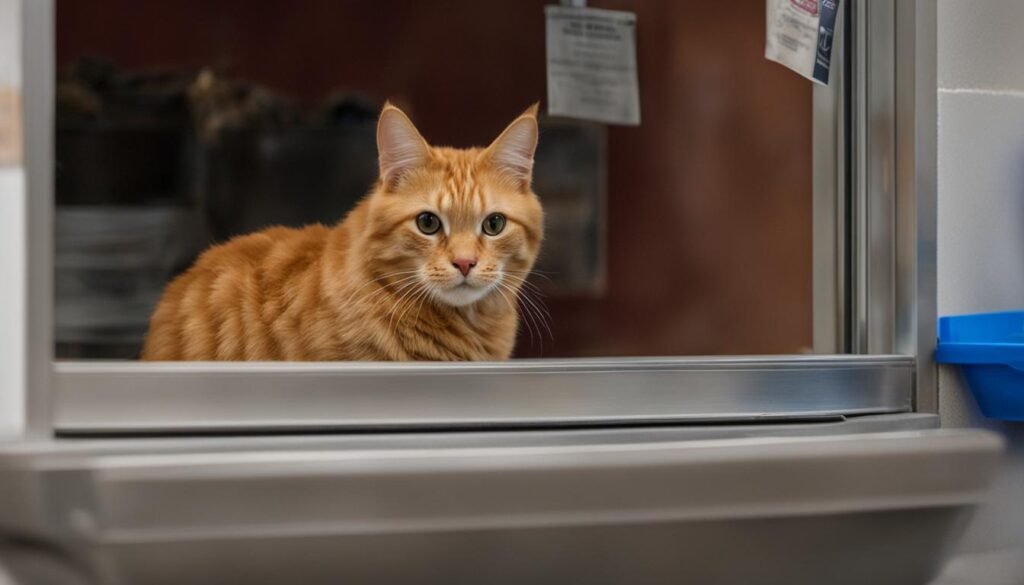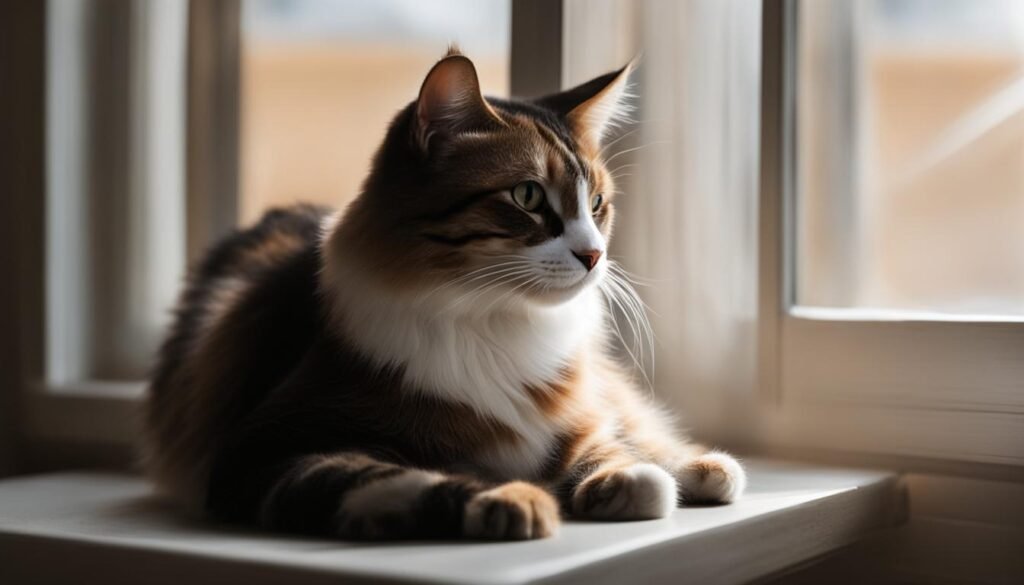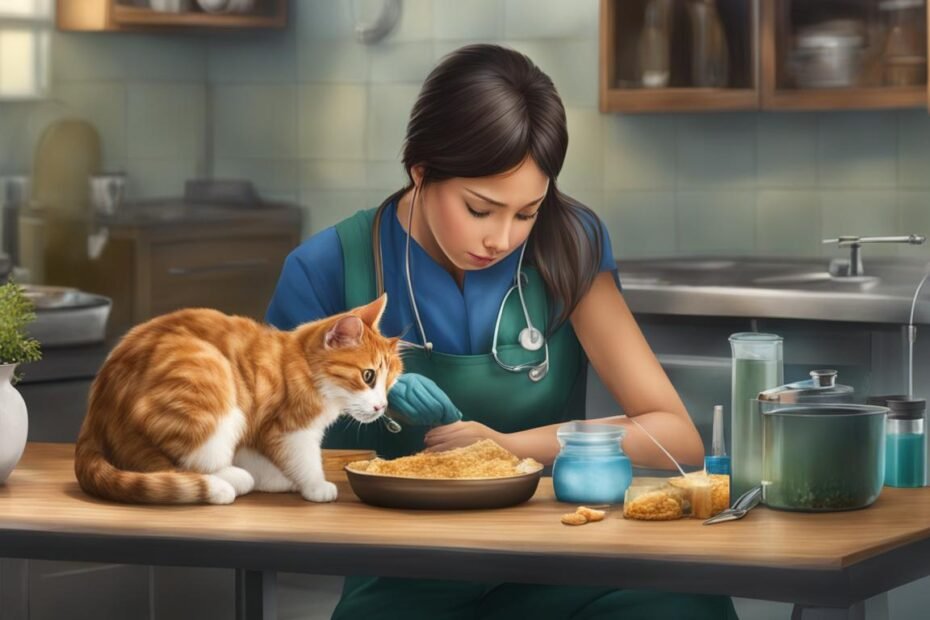Welcome to your ultimate guide to cat illness recognition! As a cat owner, it is important to be able to identify the signs and symptoms of common illnesses in cats. Early detection of health issues can greatly improve your cat’s chances of recovery and overall well-being. By understanding the common signs of illness in cats, you can determine when it is necessary to seek veterinary help. Let’s dive in and learn more about cat illness recognition and proactive cat care.
Key Takeaways:
- Recognizing the signs of illness in cats is crucial for timely veterinary care.
- Early detection of health issues in cats can lead to better outcomes and improved quality of life.
- Regular vet visits and collaboration with veterinary professionals are essential for cat illness recognition and prevention.
- Common signs of illness in cats may include changes in appetite, weight loss, excessive thirst, and behavior changes.
- If you notice any concerning symptoms in your cat, it is important to consult with a vet for proper diagnosis and treatment.
Recognizing Cancer in Cats
Cancer can affect cats just like it does humans, and early detection is crucial for their well-being. There are several common types of cancer that cats can develop, including squamous cell carcinoma, lymphosarcoma, and gastrointestinal cancer. Recognizing the symptoms of cancer in cats can help cat owners take prompt action and seek appropriate veterinary care.
Cancer in cats can manifest in various ways. Some common symptoms include the presence of lumps or swelling, sores that don’t heal, unexplained weight loss, and changes in behavior or appetite. It’s important for cat owners to be vigilant and look out for these signs, especially in older cats who may be more susceptible to developing cancer.
Diagnosing cancer in cats usually involves a combination of physical examination, imaging tests, and biopsies. Veterinary professionals will evaluate the cat’s overall health, conduct blood work, and perform specific tests to confirm the presence of cancer and determine its type and stage. Once a diagnosis is made, appropriate treatment options can be explored.
Table: Common Types of Cancer in Cats
| Type of Cancer | Common Symptoms |
|---|---|
| Squamous Cell Carcinoma | Sores, ulcers, or growths on the skin or in the mouth |
| Lymphosarcoma | Enlarged lymph nodes, loss of appetite, weight loss |
| Gastrointestinal Cancer | Vomiting, diarrhea, weight loss, loss of appetite |
Prevention of cancer in cats can be achieved through various measures. Keeping cats indoors, providing a healthy diet, and ensuring they receive regular veterinary check-ups can help reduce the risk. Spaying or neutering cats at a young age can also contribute to preventing certain types of cancer.
When it comes to treatment, options may include surgery to remove tumors, chemotherapy, radiation therapy, and immunotherapy. The specific treatment plan will depend on factors such as the type of cancer, its stage, and the overall health of the cat. The goal is to alleviate symptoms, slow down the progression of the disease, and improve the cat’s quality of life.
Understanding Diabetes in Cats
Cat diabetes is a common endocrine disorder that affects many feline companions. It occurs when the cat either does not produce enough insulin or does not respond properly to insulin. Insulin is essential for regulating blood sugar levels, so the dysfunction leads to an accumulation of glucose in the bloodstream, causing various symptoms.

Types of Cat Diabetes
There are two primary types of cat diabetes: Type 1 and Type 2. Type 1 diabetes occurs when the pancreas fails to produce enough insulin, while Type 2 diabetes is characterized by insulin resistance, where the body’s cells do not respond adequately to insulin. Both types require prompt diagnosis and management to ensure the cat’s well-being.
Symptoms and Diagnosis
The symptoms of diabetes in cats may include increased thirst, excessive urination, weight loss despite a healthy appetite, lethargy, and a dull coat. If you notice any of these signs, it is important to consult a veterinarian for a proper diagnosis. The vet will perform a physical examination, assess the clinical signs, and conduct blood work to measure blood glucose levels.
Treatment and Prevention
Treating diabetes in cats involves a combination of insulin therapy and dietary management. Insulin injections are administered daily to control blood sugar levels, while a specialized diet low in carbohydrates helps regulate glucose absorption. Additionally, regular exercise and weight management play a crucial role in preventing diabetes in cats. Maintaining a healthy lifestyle can reduce the risk of obesity, which is a significant contributing factor to the development of diabetes.
In summary, cat diabetes is a condition that requires careful management to ensure the well-being of our feline companions. Understanding the types, recognizing the symptoms, and seeking early veterinary intervention are essential for controlling the disease and improving the quality of life for cats with diabetes.
Recognizing Feline Immunodeficiency Virus (FIV)
Feline Immunodeficiency Virus (FIV) is a viral infection that affects cats and weakens their immune system over time. It is important for cat owners to be aware of the symptoms of FIV so that they can provide the necessary care and support for their feline companions. Early detection and appropriate management can help FIV-infected cats live comfortable lives for months to years.
Some common symptoms of FIV in cats include enlarged lymph nodes, weight loss, poor appetite, frequent infections, and dental problems. However, it is important to note that these symptoms may not manifest immediately. FIV-infected cats may not show any signs for years, but the disease progresses over time.
Supportive care plays a crucial role in managing FIV-infected cats. Providing a stress-free environment, a nutritious diet, and regular veterinary check-ups can help monitor their health status and prevent complications. Additionally, it is important to keep FIV-infected cats indoors to reduce their exposure to other diseases and prevent them from infecting other cats.
Summary:
- Feline Immunodeficiency Virus (FIV) weakens the immune system of cats over time.
- Common symptoms of FIV in cats include enlarged lymph nodes, weight loss, poor appetite, frequent infections, and dental problems.
- FIV-infected cats may not show symptoms for years, but the disease progresses gradually.
- Supportive care, a stress-free environment, and regular veterinary check-ups are essential for managing FIV-infected cats and improving their quality of life.
Understanding How Cats Hide Pain
Cats are masters at hiding pain, and it’s important for cat owners to understand the evolutionary reasons behind this behavior. In the wild, showing weakness can make cats vulnerable to predators, so they have developed the instinct to conceal any signs of discomfort or pain. This can make it challenging for cat owners to recognize when their furry friends are not feeling well and in need of veterinary care.
Recognizing pain in cats is crucial for their overall well-being. Cats are stoic animals that can endure significant discomfort without showing obvious signs. However, ignoring their pain can lead to further complications and a decreased quality of life. It’s important for cat owners to be proactive in identifying subtle changes in behavior, appetite, and overall demeanor that may indicate pain or discomfort.
To help cat owners and veterinary professionals assess pain in cats, the Feline Grimace Scale has been developed. This innovative tool focuses on evaluating facial expressions and body language to determine the level of pain a cat may be experiencing. The Feline Grimace Scale provides a valuable framework for recognizing pain and tailoring appropriate interventions to alleviate the cat’s discomfort.
| Feline Grimace Scale | Description |
|---|---|
| Relaxed | No signs of pain or discomfort |
| Mild discomfort | Ear changes, narrowed eyes, slightly tense facial expression |
| Moderate discomfort | Half-closed eyes, flattened ears, tension in facial muscles |
| Severe discomfort | Significantly narrowed eyes, prominent brow, flattened ears |
Pain management is a critical aspect of cat care, and veterinary professionals should be trained to recognize and address pain in cats. By understanding how cats hide pain and utilizing tools like the Feline Grimace Scale, cat owners and veterinarians can work together to ensure the well-being and comfort of our feline companions.

Tips for Cat Pain Management
When it comes to the well-being of our feline companions, cat pain management should be a top priority. As responsible pet owners, we must understand the importance of addressing pain in cats and seek guidance from veterinary professionals. Effective pain management not only enhances their quality of life but also aids in the overall recovery process.
There are various techniques and treatments available for cat pain management. Medication is commonly prescribed by veterinarians to alleviate pain and reduce inflammation. Physical therapy, such as massage or range of motion exercises, can also provide relief for cats experiencing discomfort. Additionally, alternative therapies like acupuncture and laser therapy have shown promising results in managing pain in feline patients.
“Pain that goes unaddressed can have detrimental effects on a cat’s well-being and behavior. As veterinary professionals, we play a crucial role in recognizing and addressing pain in cats. Through a comprehensive evaluation and collaboration with pet owners, we can develop customized pain management strategies tailored to each individual cat’s needs.”
Role of Veterinary Professionals in Pain Management
Veterinary professionals possess the expertise and knowledge required to identify and manage pain in cats. They are trained to assess subtle signs and symptoms that cats may exhibit when experiencing discomfort. By working closely with pet owners, veterinarians can develop tailored pain management plans that take into account the specific needs of each cat.
Regular communication and follow-up visits with veterinary professionals are essential for monitoring the effectiveness of pain management techniques. Adjustments to medication, therapy, or treatments can be made as necessary to ensure optimal pain relief and overall well-being. The active involvement and collaboration between pet owners and veterinary professionals are vital in providing the best possible care for cats in pain.
By prioritizing cat pain management and seeking guidance from veterinary professionals, we can help our beloved feline companions lead comfortable and pain-free lives. Together, we can ensure that their emotional and physical well-being is protected, enabling them to thrive and enjoy the love and care they deserve.
| Tips for Cat Pain Management | Importance |
|---|---|
| Consult with a veterinarian | To develop a personalized pain management plan |
| Administer medication as prescribed | To alleviate pain and reduce inflammation |
| Explore physical therapy options | Such as massage or range of motion exercises |
| Consider alternative therapies | Such as acupuncture or laser therapy |
| Maintain regular communication with your veterinarian | To monitor the effectiveness of pain management techniques |
The Importance of Regular Vet Visits
Regular vet visits are crucial for maintaining the health and well-being of our feline companions. These routine check-ups provide an opportunity for preventive care and early detection of health issues in cats. By following their veterinarian’s recommendations for regular check-ups and preventive care, cat owners can ensure that their furry friends receive the attention they need to stay healthy.
During regular vet visits, cats receive vaccinations to protect against common diseases and screenings to identify potential problems. These screenings can include blood tests, urinalysis, and physical examinations to assess overall health and detect any early signs of illness. Early detection is key in improving outcomes for cats, as it allows for prompt intervention and treatment.
Preventive care is another important aspect of regular vet visits. Veterinary professionals can provide guidance on proper nutrition, exercise, and parasite prevention for cats. They can also address any concerns or behavioral issues that owners may have. Additionally, regular vet visits help establish a trusting relationship between the veterinarian, the owner, and the cat, which can be beneficial in providing comprehensive and personalized care.
Benefits of Regular Vet Visits:
- Evidence-based preventive care tailored to each cat’s specific needs.
- Early detection of health issues to ensure timely intervention and treatment.
- Opportunity to discuss and address any concerns or behavioral issues.
- Establishing a trusting relationship with the veterinarian for personalized care.
“Regular vet visits are a proactive approach to cat care, focusing on prevention and early detection. By investing in regular check-ups, cat owners can provide the best possible care for their pets and ensure their long-term health and happiness.”
In summary, regular vet visits play a critical role in maintaining the overall health and well-being of cats. They allow for preventive care, early detection of health issues, and the establishment of a trusting relationship with the veterinarian. By prioritizing regular check-ups and following veterinary recommendations, cat owners can provide their feline companions with the proactive care they deserve.
| Benefits of Regular Vet Visits | Vet Recommends |
|---|---|
| Evidence-based preventive care | Nutrition, exercise, and parasite prevention |
| Early detection of health issues | Blood tests, urinalysis, and physical examinations |
| Addressing concerns and behavioral issues | Behavioral consultations and advice |
| Establishing a trusting relationship | Personalized care and guidance |
Conclusion
In conclusion, understanding cat illness recognition is crucial for proactive cat care. By recognizing the common signs and symptoms of illness in cats, cat owners can take prompt action and seek veterinary help early on. This early detection of health issues can greatly improve a cat’s chances of recovery and overall well-being.
Regular vet visits play a vital role in cat illness recognition and prevention. They provide an opportunity for routine check-ups, vaccinations, and screenings, which can help identify potential problems before they become more serious. Following the recommendations of veterinary professionals and staying proactive with preventive care is essential for maintaining the health and longevity of our feline companions.
Remember, early detection is key. The sooner we recognize and address cat illnesses, the better the outcomes. By staying vigilant, collaborating with veterinary professionals, and being proactive in our cat care approach, we can provide our furry friends with the best chance at a happy and healthy life.
FAQ
Why is it important to recognize the signs of illness in cats?
Recognizing the signs of illness in cats is important because it allows cat owners to seek veterinary help promptly, which can improve their chances of recovery and overall well-being.
What are the common signs of cancer in cats?
Common signs of cancer in cats may include lumps, swelling, sores, weight loss, and changes in behavior.
How is cancer in cats diagnosed?
Diagnosing cancer in cats often involves a biopsy and other diagnostic tests.
How can I prevent cancer in my cat?
Cancer in cats can be prevented through measures such as keeping cats indoors and spaying/neutering.
What are the symptoms of diabetes in cats?
Symptoms of diabetes in cats may include changes in appetite, weight loss, excessive thirst, and increased urination.
How is diabetes in cats diagnosed?
Diagnosing diabetes in cats involves a combination of clinical signs, physical examination, and blood work.
How is diabetes in cats treated?
Treatment for diabetes in cats typically involves insulin therapy and dietary management.
How can I prevent diabetes in my cat?
Diabetes in cats can be prevented through proper diet and exercise to avoid obesity.
What are the symptoms of Feline Immunodeficiency Virus (FIV) in cats?
Symptoms of FIV in cats may include enlarged lymph nodes, weight loss, poor appetite, and frequent infections.
How does FIV progress in cats?
FIV-infected cats may not show symptoms for years, but the disease progresses over time.
How can I support a cat with FIV?
Supportive medical care and a stress-free environment can help FIV-infected cats live comfortable lives for months to years.
Why is recognizing pain in cats important?
Cats have evolved to hide signs of pain, so recognizing pain in cats is crucial for providing timely veterinary care and improving their quality of life.
How can I manage pain in my cat?
Pain management techniques for cats may include medication, physical therapy, and alternative therapies.
Why are regular vet visits important for cats?
Regular vet visits are important for cats to receive preventive care and early detection of health issues.
What should I expect during a regular vet visit?
Routine check-ups, vaccinations, and screenings can help identify potential problems early on.
How can I ensure the health of my cat through regular vet visits?
Cat owners should follow their veterinarian’s recommendations for regular check-ups and preventive care to ensure the health and well-being of their feline companions.
